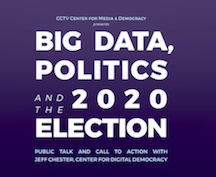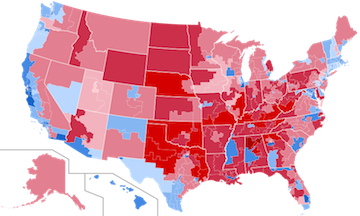
program areas Digital Consumer
Program Areas
-
Press Release
Federal Election Commission (FEC) Must Hold Hearings on Role of Digital Media in Political Campaigns
The Center for Digital Democracy calls on the Federal Election Commission (FEC) to hold hearings examining the role that the Internet and related digital data applications now play in federal political campaigns. The public needs a better understanding of how contemporary digital practices in the “Big Data” era affect our electoral system. CDD also urges the FEC to begin a rulemaking to revise its regulations concerning disclaimers so the public has appropriate access to information regarding the operations of online ads and related content. “The FEC must hold hearings to examine how, in this era of “Big Data” and personalized digital marketing, the unrestricted use of consumer information for political targeting may threaten our democratic process,” said Katharina Kopp, policy director of the Center for Digital Democracy. “Political campaigns now have access to an array of details on individuals that wasn’t previously available, including what they do online and offline. As we witnessed last year, this new capability can be used to engage in online suppression tactics to dissuade individuals and groups from voting. We urge the FEC to examine how digital data-driven campaigns may disenfranchise communities of color and economically at risk individuals." --- For more information, please see the attached media advisory and comment by the CDD. -
Political Microtargeting Threatens Privacy, Integrity of Voting Process
Big Data Election Marketing Practices Require Regulation, Safeguards
Haystaq DNA brings predictive analytics to election races up and down the ballot everywhere from presidential to city council elections. Haystaq provides support to political campaigns in need of using voter file data along with custom turnout scors, candidate support, issue scores and fundraising scores to reach voters most efficiently using a myriad of marketing tactics. --- --- For more information, visit http://bit.ly/2yrKQ0u (link is external) -
Google is a Publisher, as it Expands Video Content Services
Also bundles YouTube content and directly sells to advertisers
YouTube plans to produce a half-dozen original series that will be available for free on the world’s most popular video website, a big expansion of the Google (link is external)-owned company’s programming and efforts to attract advertisers. Comedian Kevin Hart, talk-show host Ellen DeGeneres and the comedy duo Rhett & Link are producing unscripted shows that will debut this year, YouTube will announce at an event for advertisers in New York Thursday. Alphabet Inc. (link is external)’s Google also will increase its spending on YouTube Red, a paid video and music streaming service launched in October 2015. The plans mark a shift for Google, which has typically treated its huge video library as a web free-for-all rather than a home for TV shows. But as more digital rivals venture into high-quality programming, YouTube is feeling pressure to respond, devoting resources to more costly projects and aiming for a wider audience. The company will fund more than 40 original shows and movies in the next year, spending hundreds of millions of dollars, according to a person familiar with the plans. YouTube is betting high-profile stars will attract more advertisers like Johnson & Johnson, which is sponsoring “Best.Cover.Ever,” a music competition from Ryan Seacrest that’s scheduled for later this year. “We’re working with YouTube stars and big celebrities that we know have global appeal, advertiser appeal and are largely established on the platform,” Susanne Daniels, YouTube’s head of original content, said in an interview. YouTube’s mission at the annual Newfront presentations in New York, where online companies are introducing their latest initiatives this week, is to convince marketers to shift more ad money to the web from TV. Original programming is front and center, with YouTube pitching premium shows that it says merit big commitments from sponsors. Those efforts got more complicated last month when advertisers discovered some of their spots appeared next to extremist videos (link is external). YouTube adopted new rules and said the scandal had minimal impact on sales. Still advertisers are wary of a site that relies on so many user videos, which makes it harder to ensure ads run alongside high-quality shows. “The two biggest players in the Newfronts are YouTube and Hulu, yet neither tells you exactly where your ad ran,” said Ben Winkler, chief investment officer of OMD USA, part of the Omnicom Group Inc. advertising company. “I expect YouTube will be the first to blink.” DeGeneres, who hosts one of the most popular talk shows on TV, will take viewers behind the scenes of her program. Hart, a popular comedian, will try a different trendy workout routine every week alongside celebrity guests in “Kevin Hart: What the Fit?” The show will debut on his Laugh Out Loud Network on YouTube. YouTube also will help Rhett & Link expand on their already popular “Good Mythical Morning” to create a series that feels every bit as grand as TV talk shows. While most recent episodes feature the two hosts at a desk, the revamped version, in its 11th season, will include more guests, challenges and correspondents. “We want to be seen as legit in ways by people who don’t see internet shows as legit,” said Rhett, whose real name is Rhett James McLaughlin. “But the way to do that is not to imitate late-night TV shows.” YouTube decided to fund ad-supported programs more than a year ago after executives saw a study on the growing number of TV shows being produced. Most of the new shows appear on premium services with no ads. That created an opening. --- Read more at https://bloom.bg/2y8Cdb2 (link is external) See Google program packaging for advertisers: https://www.thinkwithgoogle.com/products/google-preferred/ (link is external) -
Google Brings Big Data Personalized Ad Targeting to TV
Smarter TV Ad Breaks Automatically Optimize Your Ad Break to the Revenue-Maximizing Combination of Ads, Personalized and Relevant for Each Viewer
Google's DoubleClick team October 2017 Opt-Ed piece: I believe that the future of TV is one that’s smarter — that brings together the TV content you love with the seamless experience of digital — on every screen or surface. Building towards that future, at our Partner Leadership Summit in Chicago early this month, we announced several new products and features to DoubleClick for Publishers, made for our TV. Video ad experiences get smarter, live and on-demand, with Dynamic Ad Insertion Over the years, we’ve rebuilt our video platform from the ground up — we knew that TV was a very different experience from the web and we knew that broadcasters had different challenges, infrastructure, distribution partners and content from web publishers. With TV coming to digital, we put our stake in the future of building for a better user experience — one that was connected, always on, and on-demand. Powering dynamic ad insertion has become a leading benefit of our platform. Over the last couple of years, we’ve successfully powered dynamic ad insertion for live streaming and on-demand content for many of the largest news, sports events and episodic premiers. In fact, over the past two years alone we’ve seen a 4X increase in ad impressions delivered via our Dynamic Ad Insertion product by TV partners like CBSi, AMC, Bloomberg, TF1 (link is external) and many more. Smarter TV ad breaks optimize revenue within each pod, programmatically We’re also bringing new updates to a key feature of our platform — smarter TV ad breaks. With this update, ad slots no longer need to be sold as fixed lengths in the break. Smarter TV ad breaks automatically optimize your ad break to the revenue-maximizing combination of ads, personalized and relevant for each viewer. For example, a ninety second ad break can now be filled by two 15-second and two 30-second ads or one 15-second, one 60-second and two 6-second bumper (link is external) ads depending on what will bring you the most revenue. Importantly, we’re able to do this across your programmatic or reservation deals, while respecting your business rules, such as competitive exclusions and frequency capping within the break or stream. Content gets smarter with TV Content Explorer To effectively monetize TV content, you need a platform that can better understand the content you’re monetizing, the audiences engaging with it and serve the right ad in just the right moment no matter where users are consuming it. That’s why we’re launching TV Content Explorer in DoubleClick for Publishers, available in beta by the end of 2017. Leveraging Google’s machine learning expertise and smart heuristics, TV Content Explorer creates and automatically organizes an intuitive catalog of your shows and clips. We analyze millions of signals from video content feeds, automatically applying classifiers and making recommendations for how content should be organized across dimensions like show, genre, trending, dayparts, etc. With this inventory catalog, you’ll get a clearer view of the opportunities and packages available to sell. But that’s not all. To ensure that you aren’t leaving any revenue on the table, the Explorer will also proactively surface deeper insights into audiences and monetization opportunities via insight cards (link is external). We’re just scratching the surface of what’s possible with this feature and are excited to bring even more innovation to this Explorer in the future. --- For the full article, please visit http://bit.ly/2zvJUEk (link is external) -
Google Continues Big Data-Driven Tracking and Analyzing of Individuals for Cross-Device Targeting
Presented by the Google Agency blog "Introducing Ads Data Hub: Next generation insights and reporting"
Mobile has fundamentally changed how we live our lives. With our devices never more than an arm’s length away, people can find, watch or buy anything at anytime. That’s why earlier this year we shared (link is external) that we’re developing a new, cloud-based measurement solution for YouTube, designed for a mobile world. Today, we’re announcing the beta for this solution, Ads Data Hub, to help advertisers get more detailed insights from their campaigns across screens while also protecting user privacy. We are also announcing that Ads Data Hub is a solution not just for YouTube, but a tool that offers access to more data and helps unlock actionable insights across Google ad platforms, including the Google Display Network and DoubleClick. And with Ads Data Hub now in beta, we’re expanding who can use it. Built on infrastructure from Google Cloud, including BigQuery (link is external), Ads Data Hub gives advertisers or their preferred measurement partners access to detailed, impression-level data about their media campaigns across devices in a secure, privacy-safe environment. Data from other sources, such as a CRM system or marketing database, can be incorporated as well. With this full view, advertisers or their partners can analyze the data and draw out insights specific to their business. For example, if an e-commerce retailer wants to understand what the path to conversion looks like, they can bring additional online data about their customers into BigQuery, and Ads Data Hub will enable them to combine that data with their ads data so they can see what a typical journey is from first encountering a user until conversion. Consistent with our commitment to privacy (link is external), no user-level data can be removed from the secure Cloud environment. Impression-level data is only accessible for the purposes of analysis and generating insights. In the future, advertisers will be able to act on the insights they get from Ads Data Hub and buy media with greater precision. As an early alpha partner, Omnicom Media Group helped to define the solution and has seen significant value from both the amount of data available through Ads Data Hub and the broad set of analyses and custom queries that are possible. --- For the full blog post, visit http://bit.ly/2yBWYv1 (link is external) -
Press Release
“Smartwatches” For Parents to Monitor Young Children Actually Pose a Danger to Kids’ Welfare—Report
Groups call for investigation and action by U.S. and EU Regulators, including FTC
WASHINGTON, DC – October 18, 2017—A number of brands of “smartwatches” intended to help parents monitor and protect young children have major security and privacy flaws which could endanger the children wearing them. A coalition of leading U.S. child advocacy, consumer, and privacy groups sent a letter to the Federal Trade Commission (FTC) today, asking the agency to investigate the threat these watches pose to children. Smartwatches for children essentially work as a wearable smartphone. Parents can communicate with their child through the mobile phone function and track the child’s location via an app. Some product listings recommend them for children as young as three years old. Groups sending the letter to the FTC are the Electronic Privacy Information Center (EPIC), the Center for Digital Democracy (CDD), the Campaign for a Commercial-Free Childhood (CCFC), the Consumer Federation of America, Consumers Union, Public Citizen, and U.S. PIRG. The advocacy groups are working with the Norwegian Consumer Council (NCC), which conducted research (link is external) showing that watches sold in the U.S. under the brands Caref and SeTracker have significant security flaws, unreliable safety features, and policies which lack consumer privacy protections. In the EU, groups are filing complaints in Belgium, Denmark, the Netherlands, Sweden, Germany, the UK, and with other European regulators. “By preying upon parents’ desire to keep children safe and, these smart watches are actually putting kids in danger,” said CCFC’s Executive Director Josh Golin. “Once again, we see Internet of Things products for kids being rushed to market with no regard for how they will protect children’s sensitive information. Parents should avoid these watches and all internetconnected devices designed for kids.” The NCC’s research showed that with two of the watches, a stranger can take control of the watch with a few simple steps, allowing them to eavesdrop on conversations the child is having with others, track and communicate with the child, and access stored data about the child’s location. The data is transmitted and stored without encryption. The watches are also unreliable: a geo-fencing feature meant to notify parents when a child leaves a specified area, as well as an “SOS” function alerting parents when a child is in distress, simply do not work. The manufacturers’ data practices also put children at risk. Some devices have no privacy policies at all, and the policies that do exist lack basic consumer protections, including seeking consent for data collection, notifying users of changes in terms, and allowing users to delete stored data. "The Trump Administration and the Congress must bring America’s consumer product safety rules into the 21st century,” said Jeff Chester of the Center for Digital Democracy. “In the rush to make money off of kids’ connected digital devices, manufacturers and retailers are failing to ensure these products are truly safe. In today’s connected world that means protecting the privacy and security of the consumer—especially of children. Both the FTC and the Consumer Product Safety Commission must be given the power to regulate the rapidly growing Internet of Things marketplace.” The Caref (branded Gator in Europe) and SeTracker smartwatches are available online through Amazon. The groups have asked the FTC to act quickly to investigate these products, and they advise parents to refrain from buying the products because of the danger they could pose to children. The NCC, which conducted the testing of the watches, advises consumers who have already purchased the watches to stop using them and uninstall the app. “The Federal Trade Commission must be proactive in protecting consumers—especially vulnerable young children—from harmful products that abuse technology for the sake of profit,” said Kristen Strader, Campaign Coordinator for Public Citizen. “Smartwatches and similar devices must be absolutely safe and secure before they are released to the public for sale.” Ed Mierzwinski, Consumer Program Director at U.S. PIRG, said, "Companies making any internet-connected devices, but especially for children, need to ensure that privacy and security are more than breakable — or worse, hackable — promises." Katie McInnis, technology policy counsel for Consumers Union, said, “When a company sells a smartwatch aimed at children, it must ensure the product is safe and secure. The FTC should launch an investigation into the privacy and security concerns surrounding these products to make sure families are safe.” The same trans-Atlantic coalition persuaded government authorities and retailers last December (link is external) that the internet-connected dolls Cayla and i-Que Robot were spying on children and threatening their welfare, and retailers removed the toys from store shelves. The FBI subsequently issued a warning to consumers (link is external) that internet-connected toys could put the privacy and safety of children at risk. --- For more information, please see the following: Letter to FTC by coalition of leading U.S. child advocacy, consumer, and privacy groups (link below) Press Release by US coalition of leading U.S. child advocacy, consumer and privacy groups (link below) #WatchOut Report by Norwegian Consumer Council (link below) Press Release by Norwegian Consumer Council (link below) #WatchOut English - YouTube (http://bit.ly/2ghNoD1 (link is external)) #WatchOut - longer video explainer on security flaws 4:30 mins - YouTube (http://bit.ly/2xLYSVv (link is external)) -
Digital Data Targeting of Political Ads Require 21st Century Voting Safeguards, inc. for Privacy
Here’s what Verizon does:
'One by AOL: Politics', a full-scale programmatic solution that inspires voters at the "right time", in the "right context" in an increasingly video and mobile-led world. Use of this platform allows political brands to create, execute and optimize on digital buys to reach voters. --- For more information, visit https://www.onebyaol.com/politics (link is external) -
Google + Ad Industry Study Shows Influencers on YouTube Sell Snacks, Toys, Alcohol
Illustrates Need for 21st Consumer Safeguards for Unfair/Deceptive Marketing
Sanjay Nazerali, Chief Strategist of Carat, a global media market leader in digital media, writes about how YouTube influencers are rewriting the marketing rulebook. Working in strategy at one of the world’s largest media agencies, I’ve witnessed countless pitches about influencer marketing and the growing power of creators. With engaged audiences in the millions and passionate fans hungry for content, YouTube creators are already an established channel for brands looking to run ads. In fact, Carat’s latest analysis suggests online video investment (including YouTube) can be increased by 3X compared to planned level. But increasingly, these influencers are also becoming attractive partners for deeper collaborations. Clients are initially enthusiastic, assuming this is the digital age’s answer to celebrity marketing and endorsement. Then the thorny business questions arise, such as: So what’s it actually doing for my brand? Do I do an endorsement or product placement—or what? Isn’t it just for millennials, beauty brands, and makeup tutorials? These have always been tough questions to answer. Even though almost everyone has been jumping on the influencer bandwagon, few understand what “influence” really is or how it works. Until now. Celebrity marketing and influencer marketing offer fundamentally different benefits for brands. Together with YouTube and Nielsen, my team analyzed the results of hundreds of brand and creator videos in the U.S. and the U.K to understand the impact of influencers for brands. It’s a critical first step in establishing a business-led rulebook for this new world—and it’s already changing how I approach my own plans. 1. Influencers are not the same as celebrities Influencers, however vast their reach, are absolutely not “today’s celebrities,” and celebrity marketing and influencer marketing offer fundamentally different benefits for brands. For instance, we found that celebrities are more effective at driving recall than creators (84% versus 73%). Given that a celebrity’s job is to be famous and memorable, that makes sense. Where YouTube creators really start to gain the upper hand is in deeper brand involvement. Brand familiarity is a good example. If we want to get an audience to really understand us, our work, our values, or our products, then collaborations with YouTube creators are 4X more effective at driving lift in brand familiarity than those with celebrities. When it comes to purchase intent, it’s an even match: our research found that influencers were just as likely as celebrities to drive buying decisions. Influencer marketing appears to play a fundamentally more pragmatic role. Why? My hunch is that it’s because fans feel very connected to the YouTubers they love. The best creators have formed authentic bonds with their fans, which means fans trust what they have to say, and turn to them for brand and product recommendations. 2. It’s not just a ‘beauty’ thing Beauty brands were one of the first to team up with influencers, and creators have established a huge presence among the YouTube beauty community. About 86% of the top 200 beauty videos on YouTube were made by creators rather than professionals or brands. But what’s interesting about our findings is just how far influencers stretch beyond the beauty category. We tested nine additional categories, including auto, alcohol, snacks, and toys. Across all nine categories, working with influencers leads to lifts in brand metrics, from familiarity to affinity to recommendation. In some categories, such as snacks and alcohol, they can have even more impact, driving significantly higher than average purchase intent. So the idea that influencer marketing is purely for young people who are looking at fashion and beauty brands simply isn’t true. 3. The ‘how’ matters as much as the ‘who’ Celebrity marketing has historically focused on endorsement, sponsorship, and product placement. Influencer marketing has developed far more options, and it’s important to understand which of these work best—and for which marketing goals. Deep thematic integrations with creators stand out as driving the highest results for brands. These are more involved integrations where the influencer plays a role in creating a piece of content – such as a demo – with the brand. It’s far deeper than product placement and it works more effectively. While there were many consistencies across categories, we also saw some nuances, which are important for clients to understand. We found that simpler brand integrations, like a product endorsement or just featuring a creator in an ad, also showed positive results for brand affinity in all categories tested. Of course, deep collaborations can be more than some brands are ready for. For some objectives and categories, simply running their own ads on YouTube creator content will still be the easiest and most effective way to tap into the power of these influencers. 4. Don’t lose sight of why people love YouTubers We often assume that the right influencer is either an aspirational version of our target audience or that they’re just like celebrities. Neither of these assumptions is correct, and it’s perhaps here that celebrity and influencer marketing differ the most. Whereas celebrities need to be trendy and stylish, consumers expect creators to be friendly, funny, and, yes, sometimes irreverent. Irreverence is interesting, because it drives credibility. Irreverence strongly suggests independence, and it’s this that builds trust. It can also be incredibly valuable for brands. If a creator usually ridicules things they don’t like, you can be sure that when they praise something, they mean it. Humour is also interesting, because it reflects a sense of community. YouTube helps forge a special relationship between followers and influencers, one that reflects a sense of co-ownership. This familiarity creates a degree of intimacy that makes the use of humour seem much more natural than it would do with celebrities. This is probably also why we see celebrities, such as Dwayne Johnson, increase their influencer scores when they get really active on YouTube. Prioritization and strength of attributes by gen X and gen Y associated with celebrities are different to creators. --- For the full article, visit http://bit.ly/2z6MHng (link is external) Is it Hype? Or is it Real? Decoding the Influence of YouTube Influencers Read more at http://newyork.advertisingweek.com/CALENDAR/-google-seminar-2017-09-26-1... (link is external) -
Leading radio streaming service Pandora partners with Oracle Data Cloud (link is external) on two important measurement initiatives: a custom offline sales meta-test of consumer packaged goods (CPG) campaigns and automotive Buy Through Rate (BTR) measurement. Connecting online ad exposure to offline sales requires billions of data points. Massive scale is crucial. With more than 76 million logged-in listeners per month, 1 billion data signals every day, and cross-platform reach, Pandora is uniquely positioned to provide our advertisers with the crucial data they need. In both the CPG and Auto studies, Pandora‘s listener data was matched anonymously, one-to-one with Oracle Data Cloud user-level data set. Pandora’s cross-platform media was then connected with offline transactional consumer data from the Oracle Data Cloud. For marketers, being able to accurately measure a campaign’s impact on in-store sales truly is the holy grail. With 67% of the buyer’s journey (link is external) happening online, digital marketing has never been more directly connected to offline sales. It’s also the thing that keeps marketers awake at night and a challenge that here at Pandora, we’ve taken to heart. Campaign-level sales insights are equally important for automotive marketers as their CPG counterparts. Yet, auto purchase cycles are even longer and more complex, making sales attribution a struggle. Pandora is proud to lead the charge in this space and is the first non-endemic publisher to leverage Oracle Data Cloud Buy Through Rate at a raw impression/user level, exposing detailed and granular campaign-level insights. --- For more information, visit http://bit.ly/2g3Ic5u (link is external)



